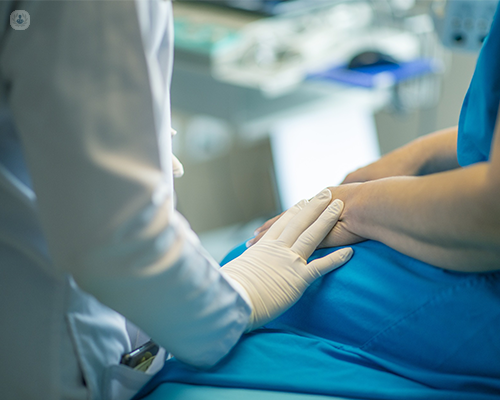Diagnosing bladder problems with cystoscopy
Autore:Mr Simon Brewster is a consultant urological surgeon with expertise in all areas of urology, including diagnoses using a cystoscopy. In this article, he clarifies what this procedure entails, if it hurts and what to expect from the procedure.

Why is cystoscopy performed?
A cystoscopy is performed to visually inspect the internal lining of the urethra (the pipe through which the bladder empties urine) and the urinary bladder using a telescope (often called a camera). It is usually carried out by a urologist or specialist urology nurse, but occasionally by a specialised gynaecologist. The most common conditions that indicate the need for cystoscopy in diagnosis are:
- blood in the urine ( haematuria )
- recurring urinary tract infections
- gas bubbles in the urine
- passage of stones in urine
- a painful bladder
A cystoscopy can also be used as a way of getting access to the tubes leading from the kidneys to the bladder (known as the ureters) so that they can be inspected (ureteroscopy) or imaged using injected dye (ureterography) if, for example, there is a suspected blockage or stone.
What are the types of cystoscopy?
Cystoscopy can be performed using a thin flexible fibre-optic endoscope an outpatient procedure. Usually, a local anaesthetic gel is used and there is no need for sedation. Alternatively, as a day case procedure without the need for an overnight stay in hospital: a rigid metallic endoscope under a general or regional anaesthetic, or sedation, can be used.
How is cystoscopy performed?
Men are positioned lying flat. Women are positioned lying flat with their knees bent and heels together. This position will be familiar to all mothers who have delivered a baby vaginally.
Typically, a cystoscopy takes around 5 minutes to complete. The skin at the urethral outlet (on the end of the penis in men and just inside the vagina in women) is cleaned with an antiseptic. The local anaesthetic gel is then applied to the urethra using a syringe (not with a needle!) and it takes a few minutes to take effect. As it is just a surface gel it is never 100% effective at numbing the urethra, but it helps and also acts as a lubricant. The endoscope is then gently passed down the urethra, through the prostate gland (in the case of males) and into the bladder. Throughout the procedure, the lining of the urethra and bladder are systematically inspected and the description and position of any abnormality can be noted.
Does a cystoscopy hurt?
A flexible cystoscopy under local anaesthetic is best described as uncomfortable (and rather undignified) by patients. A cystoscopy under general anaesthetic should not hurt, although passing urine afterwards can sometimes sting a little temporarily.
What may also happen during a cystoscopy?
Occasionally a slightly tight area of the urethra (sometimes called a stricture) may be gently stretched during the passage of the cystoscope. A very tight urethral stricture requires a formal procedure called a urethrotomy to open it up, which would always require a general anaesthetic.
If an abnormality in the bladder lining is seen, a tissue biopsy can be taken for pathology analysis and the biopsy site cauterised (burned with a heated tool to close the tissue and prevent infection). This is best performed when under general anaesthetic because it can be a little painful if done under a local anaesthetic, although it is possible.
What are the possible complications of cystoscopy?
Occasionally, a little bleeding or a urinary infection can occur following a cystoscopy. Your health care professional will warn you about this and any more specific complications that could rarely occur following your cystoscopy. It is usually advisable to stop anticoagulants and rule out an untreated infection before a cystoscopy, but your specialist should advise on these points in advance.
Mr Simon Brewster is a urologist with over 25 years’ experience in assisting patients with bladder problems, prostate cancer, blood in urine and more. Visit his profile to learn how he can help you.


